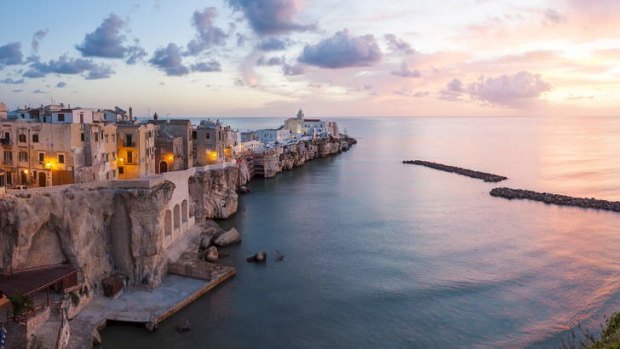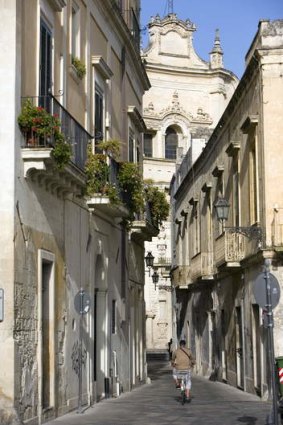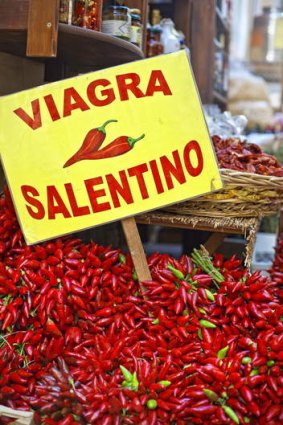
Peace and quiet: the magical coastline of Puglia.Credit: Getty Images
Ben Groundwater escapes the crowds and is charmed by the sleepy, laid-back life in the boot-shaped country's stiletto.
There's something missing in Puglia. It takes a while to sink in as you stroll past the Roman amphitheatre, as you wander the cobbled pedestrian streets, as you pick your way through crumbling old churches and walk along seaside promenades. Something's not right.
The feeling hits hardest about 2pm, when places such as Lecce and Taranto become ghost towns, the shutters all pulled down over shop windows, the streets quiet, the pavements empty. It's eerie and it makes you realise that what's missing here is what seems to be in abundance everywhere else in Italy: people.

The sandstone streets of Lecce.Credit: Getty Images
Not just local people but travelling people; the tourists. The ones like you. You get used to it up north, the feeling of rubbing shoulders with camera-toting tour groups as you strain to see that painting, that sculpture, that monument. But not here in Puglia. There's no one here.
Maybe it's the region's position. There's little glamour in being the heel, but that's the geographical gift bestowed upon Puglia, the stiletto to Italy's fashionable boot. It's a trek to make it down here, a day-long train ride from Rome through progressively drier, starker scenery.
Things are different down here in the south. Siesta is observed with military precision - but that's about the only thing that is. There's a charming sense of haphazardness to the rest of the day, a feeling that whatever happens will happen; and it will happen when it decides to. I arrive in the town of Lecce at 3pm, bang in the middle of siesta. There's no one around. No one. It's like the set of a zombie apocalypse, with bits of newspaper flapping across empty streets.

Hot peppers for sale in Lecce district.Credit: Corbis
My taxi driver is excited. Not just for the fact that she's scored a fare during a zombie apocalypse, but because she just doesn't see many tourists down here, let alone foreign tourists.
She's not letting the language barrier get in the way of her enthusiasm for her home town. She grips my leg as we race towards my hotel, trying to secure my attention as she points out sights with flailing hands while occasionally using the steering wheel. I can only catch a few words: "baroque", "Lecce" and "bellissimo" crop up frequently.
And that's all the information you need.
It's beautiful here in a small-town, old-school Italian way. Bellissimo. There's a cosy feeling of community, something you won't find in the bigger cities. Lecce's pedestrian areas are paved with limestone; the churches that pop up in every street and alley show all of the wild excesses of baroque architecture, their facades intricately adorned with bold stone carvings. The town's central piazza is home to the sunken remnants of a Roman amphitheatre. Built in the second century, it once held 25,000 people, but these days holds no more than the passing attention of the local population. The few tourists who are in Lecce tend to wander around and snap photos of the ruins before drifting off down one of the narrow pedestrian streets leading off the square.
Down one of those alleys sits the duomo, the town's main cathedral. Like much of Puglia, it's not as instantly incredible as something you might find in Rome, but it rewards those prepared to explore. It might appear small, but once inside the cathedral you notice the stained-glass windows that the church is famous for, rows and rows featuring saints and Bible scenes.
Next door to the duomo, the Bishop's Palace is a beautiful old building that is still inhabited, to the point where there's even a street number on the door. Puglia is like that - lived in. Even the piazza itself is lined with terrace houses rather than restaurants peddling €5 ($6.90) coffees.
I decide to wander in search of food, hoping for the cuisine Puglia is famous for, the tomato-rich orecchiette pasta dishes or the burrata - pillows of mozzarella with soft, creamy centres. Instead I settle on a pizzeria, a little local joint called Pizzeria La Perla. An entire salami pizza here costs €4. Half a bottle of red wine is €5. An espresso to round out the meal is just a euro more. That's a lot of good food and drink for the equivalent of about $13.
But you can't come to Puglia and not go to the seaside. The next day I'm back on a train and heading for the port town of Taranto in the region's north-west. If there were few tourists in Lecce, there are even fewer in Taranto. It feels distinctly locals-only as I stroll across the bridge separating the new town from the old.
The old town in Taranto isn't just a figure of speech - it's falling apart. Scooters zoom through narrow streets, stray dogs lie in the shade, while all around, the buildings look as though they could tumble down at any moment. With its boarded-up windows, rusting balustrades and crumbling facades, it can be hard to believe that anyone actually lives here. But at night the old town comes alive, with men sitting on the streets watching football on TVs that have been dragged out beside them, and people spilling out of lively bars.
There's a dilapidated charm to Taranto. Washing hangs from every window. Men hang in cafes drinking espresso.
Back near the bridge, Taranto's crowning glory, Castel Sant'Angelo, commands views across the shimmering Mediterranean. There are hourly tours of this 15th-century castle, right through until 1.30 in the morning, but there's just one small problem: they're only conducted in Italian. Still, it's nice to wander the castle grounds and see how many of the tour guide's words you can understand. "Bellissimo" seems to crop up frequently.
Ben Groundwater stayed as a guest of the Italian Tourist Office.
FAST FACTS
Getting there Emirates has a fare to Rome for about $2035 low-season return from Sydney and Melbourne including taxes. Fly to Dubai (about 14hr) and then to Rome (6hr 25min). Phone 1300 303 777; see emirates.com/au. From Rome, Trenitalia trains run direct to Lecce, or change at Bari to get to Taranto. See trenitalia.com.
Staying there In Lecce, Hotel President has spacious rooms from $70 a night. See hotelpresidentlecce.com. In Taranto, Hotel Akropolis has rooms from about $88 a night. See hotelakropolis.it.
More information www.enit.it
Sign up for the Traveller Deals newsletter
Get exclusive travel deals delivered straight to your inbox. Sign up now.